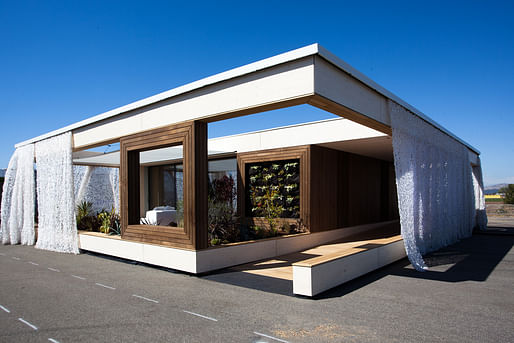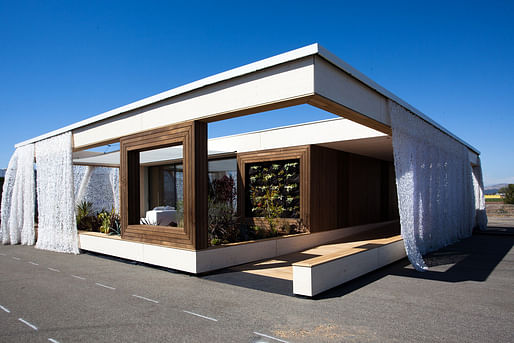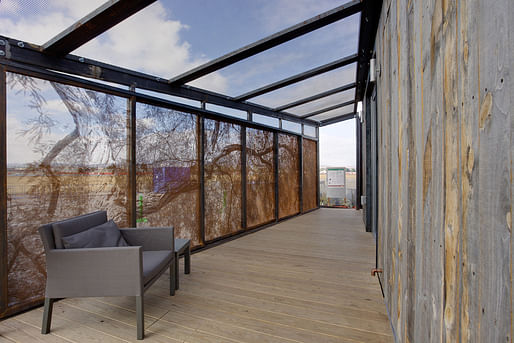

Plopped down on a former Marine Corp air station in the geographic middle of Orange County, nineteen solar-powered model homes line the runway to be judged in the U.S. Department of Energy’s 2013 Solar Decathlon. For its first year held away from the National Mall in Washington D.C., the Solar Decathlon was staged in Irvine’s Great Park, which while being an abandoned airstrip surrounded by farmland, housing developments and dirt, purports to be the “first major metropolitan park of the 21st century”. For ten days, collegiate teams from around the world showcased their houses for public tours and competition in ten categories that grade affordability, marketability, design and energy efficiency. Each team has architects and engineers (sometimes from multiple schools) collaboratively design and build a fully functional solar-powered home for their chosen environment.
What does the Department of Energy do with these winning designs once the competition is over? Anticlimactically, most of them are sold, or return to their campus to be honored or put to use. There is no practical prize awarded for winning, although all teams benefit from the chance to meet and learn from an incredible variety of students and teachers. The program is more of a venue to raise awareness and publicize the “beautification” of solar technology, but that seems like a major missed opportunity. When touring the houses, the mood more resembles a virtual walk through Dwell magazine than a solar-tech trade show, or visions of future sustainable housing. This is patently disappointing, given that solar and “zero energy building” designs are most effective in reducing energy bills when implemented in new constructions — exactly like the homes competing here. The DOE should incentivize novel solar retrofits and adaptations to building codes of pre-existing homes, for those that desperately need to catch up to energy standards, and inhabitants who can’t buy a new home, no matter how affordable.
As it stands, solar’s cost prohibits it from competing with the lowest-hanging-nearly-fully-rotten-fruit: petroleum, coal and natural gas. The DOE’s “SunShot Initiative” (2011) aims to cut costs of photovoltaic solar energy systems by 75% by 2020, putting solar in competition with other forms of electricity*. California Governor Jerry Brown also signed legislation in 2011 to require California’s utilities to get a third of their electricity from renewable energy sources by 2020**. Why not coordinate these initiatives with the massive educational and corporate resources represented at the Decathlon? The first Solar Decathlon was in 2002 — now an established tradition, the competition should be fully coordinated with federal sustainable planning measures, and be put to work.
Passing through the Irvine fairgrounds, Archinect toured a selection of the structures and spoke with team members — what stood out were distinctive details, if not any overarching architectural visions. Here are our findings:
AUSTRIA

Walking into the Decathlon-winning LISI house by Team Austria — a collaboration between Vienna University of Technology and three other Austrian universities in Vienna, Salzburg and Sankt Pölten — I was pleasantly impressed by its very simple yet strikingly transformable cubature. Two massive glass sliding doors on either side of the wooden cube connect to patios, and when opened up in its entirety, they make not only for excellent cross-ventilation but also create a balance between interior and exterior, public and semi-public spaces. Within a few seconds, the living area can be enlarged from 650 to almost 1,000 sq ft.

White exterior drapes (repurposed camouflage nets) can be zipped around the house as needed to create privacy in the living area, provide shading in the summer months, and cast an intricate pattern of, what feels like, sunlight filtered through the house’s main inspiration: the tree.
Hailing from a mountainous country vastly covered by lush forests, Austria’s team is proud to point out that the structure is made out of 96% wood, all domestically sourced of course. The interior finishes are beautiful and impress with smart details and furniture pieces custom-designed by the students.
Besides the ubiquitous PV solar panels on the roof and the usual must-have ‘green building’ gear, the Austrian engineering students also threw some other smart high and low tech solutions in the ring: instead of boasting a huge, resource-hungry refrigerator, the team opted for a rather small model and provided an aptly-sized vegetable storing closet which keeps its cool by evaporative cooling — no electricity needed. Also creating further savings is a system installed in the bathroom that regains heat from waste water while showering which is then used to heat the new water.
UNIVERSITY OF NEVADA, LAS VEGAS

Winning first place in the Market Appeal category and second in the overall competition, the Mojave Desert-inspired Desert.Sol from UNLV pulls on multiple regional histories. Guided by the its principal investigator, Eric Weber, I learned that the two-person vacation home is the first of UNLV’s design/build classes, and was directly inspired by the particular desert environment surrounding Las Vegas. Now of course a gambling destination, Las Vegas' natural spring was well-known in the 19th century, before it was settled by American Mormons and then used as a mining town. In the extremely harsh desert climate, the main building concerns were aging, water conservation and interior temperature.

The exterior’s metal detailing and weathered wood siding were sourced to age gracefully in the harsh desert environment, while a water casing running along the middle of the house catches rainwater to wholly sustain the outside garden of native plants. On the back porch, a perforated metal screen provides dappled shade into the bedroom — a neat digital-pointillist technique rendered using Grasshopper to resemble the bark of the Mesquite tree, native to the Mojave. The interior provides both private and public space, with a segregated bedroom and a retractable wall between the entertainment and kitchen spaces. While a bit cramped with objects, the interior is furnished with one-of-a-kind, student-designed furniture, featuring wooden and metal elements echoing the outside’s textures and the city's mining history.
CZECH REPUBLIC

The approach to Czech Technical University’s submission, AIR House, is quiet and unassuming — nearly the entire house is made of wood, lending a light and breezy atmosphere to the transitions between entrance, interior and exterior. Designed for retiring couples in the Czech Republic, the strategy rests on the “house within a house” Passivhaus principle, which balances a no-frills interior with an expansive exterior. AIR encourages outdoor activities by blending the kitchen and entertaining spaces with the outside porch, which, as a home for retirees, may seem surprising. But the back-patio is both inviting and multi-functional, with a chalkboard facade, an electric-bike charging station and an edible garden. The strong focus on social-space was directly inspired by the Czech team members, most of whom’s parents belonged to the target demographic.

AIR won first prize in Architecture and second in Engineering, and the public’s reaction was clearly positive — the chalkboard rear facade was covered in well-wishes and cheerful exclamations. Many refer to the smell of the wood construction, which even in the midst of Santa Ana winds and Great Park’s open runway, retained a warm, resiny scent.
STANFORD UNIVERSITY

Start.Home by Stanford University is the school’s first ever entry at a Solar Decathlon — and right out of the gate, managed to come in among the Top 5 in the Overall Competition. The modular concept radiates a confident Silicon Valley spirit with a clear focus on market appeal and prefabrication to minimize costs, making sustainable living more affordable. The house won one of the Affordability Awards by coming in at under $250K for the entire house, including all technical equipment, appliances, deck, landscaping, and construction labor.
Stanford’s concept spins around a prefabricated CORE module which includes a kitchen counter and selected appliances, bathroom and laundry room, and a mechanical room with integrated electrical and plumbing systems — creating a “standard energy framework” which the rest of the house can then be custom-developed around. The CORE module fits on a standard flatbed trailer and can be scaled to fit demands of different family sizes as well as optimized for various climate zones and their specific challenges. By preconfiguring the CORE in the factory, the design team takes inspiration from the automotive industry, hoping to make the complex integrated energy systems a lot more accessible to the average homeowner, who might otherwise not know how to get a good head start at sustainable building.

The climate concept balances proven Passivhaus strategies with cutting-edge technology, such as a phase-change material in the ceiling: a wax-like substance, encased in thin aluminum sheets, that starts to melt when it gets hot during the day, therefore absorbing heat from the inside air, and releases heat at night when it turns solid again, keeping the interior temperature consistent and comfortable while using little to no energy.
More hints from the Tech industry can be found in the design of the light switches (or the lack thereof — touch pads in every room let users control lights, fans and outlets), and the building energy management system (a digital control panel gathers and visualizes electricity and water-use data to the occupants, setting goals and motivating progress).
MIDDLEBURY COLLEGE

Perhaps the most memorable aspects of my somewhat rushed visit through Middlebury College's InSite house was the team's upbeat, friendly demeanor and the clean presentation of the space. After being handed a brochure by a team member, I joined a group that was about to begin a guided tour. As another student welcomed us, the first thing that caught my attention was that the solar panels weren't on the roof, as seen in other houses. Instead, they were installed like an awning to create an exterior "solar path" that leads to the house. Like a public attraction, visitors exchanged comments and snapped photos as we walked underneath the solar panels before entering the house.

Designed for the young local Vermont family in mind, the main gathering area felt like a modern cabin house whose aesthetics would indeed easily appeal to younger homeowners. The choice of furniture and its arrangement, high ceilings, and a generous amount of light coming through the windows showed off the house's open floorplan nicely. Additionally, the steel kitchen appliances against the smooth reclaimed wood gave the entire space a polished feel. I ventured through the hallway and while unable to explore the cozier bedrooms (off-limites to visitors), I found solace at the neat window seat at the hallway's end.
SANTA CLARA UNIVERSITY

Painted in a calming shade of blue surrounded by California-style foliage and ramps that lead into the house, the Radiant House by the Santa Clara University team already conveyed a sense of comfort and relaxation as I approached it to meet Brian Grau, the Public Relations Lead and a mechanical engineering student on the team. As Brian led me on a tour through the house, I learned that just about every element is designed for the team's target market of "empty nesters" and newly retired folks living in a California climate — a central family gathering area surrounded by windows and doors that directly lead to the front patio of the house; adaptable furnishings and arrangements for senior residents; a tame palette of greens, blues, and stone colors.

One unique aspect of the Radiant House is its substantial use of bamboo including the ramps outside that encircle the entire house, soft bamboo towels in the bathroom, and the structural wall and joist system—which consists of mixed lumber and mostly raw bamboo. Although the SCU team sees it as an innovative building material they'd like to see used more in developed countries, the DOE saw otherwise—much to the team's frustration—saying it was unproven technology.
"Yes, by definition any new technology is unproven, and we're demonstrating it here," Brian explained to me. "Someone has to be the first to use it. Someone has to be that first explorer—Columbus coming to America. Someone has to be the first one. But because it's unproven, people don't like change very much, so they're very resistant to that."
SCI-ARC & CALTECH

Californian pair SCI-Arc and Caltech teamed up for the Dynamic Augmented Living Environment (DALE), a two-module unit set on rails, enabling it to split apart at the touch of a button. The in-between space then becomes a multi-use outside space for the resident, but if a 3-person family (DALE’s demographic) were actually going to live here, it’s unlikely they would want to continually modify their living spaces for different efficiencies.
 It didn’t seem practical, opening up the entire house to the elements, when the house was small enough to allow for permanent outdoor activity space. The energy required to move the entire house could probably be put to better use, even if it does make for a cool party trick.
It didn’t seem practical, opening up the entire house to the elements, when the house was small enough to allow for permanent outdoor activity space. The energy required to move the entire house could probably be put to better use, even if it does make for a cool party trick.
ARIZONA STATE UNIVERSITY & UNIVERSITY OF NEW MEXICO

SHADE, from Arizona State University and the University of New Mexico, is another take on design for the extreme desert climate of the southwestern United States. Its name is perfectly suited, providing very natural sun protection and a comfortable interior atmosphere. To keep the house cool, an “ice-induced ambient cooling strategy” distributes heat at peak temperatures, cooling the entire atmosphere rather than flooding it with cold air — as one of the tour guides put it, “it feels like walking into a cool cave, rather than having cold air blown on you.”

The ice cooling tubes work with phase-changing heat absorption panels in the ceiling, moderating the intense desert heat. The interior is highly flexible, outfitted with modular and collapsible Resource Furniture to configure space into almost any room.
More photos of all of the houses can be found via the DOE's Solar Decathlon flickr photostream.
*"DOE's SunShot Program Aims to Reach Competitive Solar By 2020". Ariel Schwartz, Fast Company, (Feb. 4, 2011).
**"Brown signs law requiring 33% renewable energy". David R. Baker, San Francisco Chronicle (April 12, 2011).
Authors:
Paul Petrunia: SCI-Arc/Caltech; Arizona State University/University of New Mexico.
Amelia Taylor-Hochberg: Introduction; University of Las Vegas, Nevada; Czech Republic
Justine Testado: Middlebury College; Santa Clara University
Alexander Walter: Austria; Stanford University
2 Comments
Thanks for the nice writeup on our house! It was an exceptional experience working on this project, and it was fascinating meeting the other teams; the rich diversity of approaches was refreshing, and the camaraderie among the teams was particularly memorable. I congratulate Team Austria and the Czech Republic teams on their strong performances, as well; the top three teams were all newcomers to the competition, and 9 points separated 1st through 3rd places, the closest finish ever.
Eric Weber, Principal Investigator
Team Las Vegas, US Dept. of Energy Solar Decathlon 2013
It is unfortunate that Paul Petrunia would dismiss the SCI-Arc/Caltech Project as impractical for a 3 person family. Each of the Solar Decathlon entries was designed for its own specific target market, and judged accordingly. DALE (Dynamic Augmented Living Environment) was designed with a young millennial couple in mind. Additional family members added over the natural course of a lifetime would, as the team anticipated and explained during tours and in their architecture narrative, warrant an additional living module, something that the system was specifically designed to easily accommodate.
The total energy used to move both modules across the site is roughly 0.05 kilowatts ( the same amount of energy it takes to power a 50 watt light bulb for an hour). This simple and surprising fact is at the core of DALE's energy strategy. Designed specifically for the inland Southern California environment, DALE's users can choose to spend this tiny amount of energy to open the house, increasing the overall footprint of their living environment (something we do here in SoCal 85% of the year), while allowing California to effectively become their air conditioner, thus saving loads of energy and cost.
Ironically, quoting the paragraph just above the SCI-Arc/Caltech write-up in this article "...Someone has to be that first explorer—Columbus coming to America. Someone has to be the first one. But because it's unproven, people don't like change very much, so they're very resistant to that." Over time, moving architecture will become the norm.
Block this user
Are you sure you want to block this user and hide all related comments throughout the site?
Archinect
This is your first comment on Archinect. Your comment will be visible once approved.